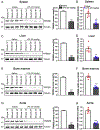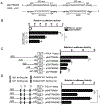TRIM59 expression is regulated by Sp1 and Nrf1 in LPS-activated macrophages through JNK signaling pathway
- PMID: 31883458
- PMCID: PMC7773022
- DOI: 10.1016/j.cellsig.2019.109522
TRIM59 expression is regulated by Sp1 and Nrf1 in LPS-activated macrophages through JNK signaling pathway
Abstract
Activated macrophages play an important role in many inflammatory diseases including septic shock and atherosclerosis. TRIM59 has been showed to participate in many pathological processes, such as inflammation, cytotoxicity and tumorigenesis. However, the molecular mechanisms controlling its expression in activated macrophages are not fully understood. Here we report that TRIM59 expression is regulated by Sp1 and Nrf1 in LPS-activated macrophages. TRIM59 is highly expressed in macrophages, and markedly decreased by LPS stimuli in vivo and in vitro. TRIM59 promoter activity is also significantly suppressed by LPS and further analysis demonstrated that Sp1 and Nrf1 directly bound to the proximal promoter of TRIM59 gene. LPS treatment significantly decreased Sp1 expression, nuclear translocation and reduced its binding to the promoter, whereas increased Nrf1 expression, nuclear translocation and enhanced its binding to the promoter. Moreover, LPS-decreased TRIM59 expression was reversed by JNK inhibitor. Finally, TRIM59 level is significantly decreased during atherosclerosis progression. Taken together, our results demonstrated that TRIM59 expression was precisely regulated by Sp1 and Nrf1 in LPS-activated macrophages, which may be dependent on the activation of JNK signaling pathway and TRIM59 may be a potential therapeutic target for inflammatory diseases such as atherosclerosis.
Keywords: Atherosclerosis; Macrophage; Nrf1; Sp1; TRIM59.
Copyright © 2019 Elsevier Inc. All rights reserved.
Conflict of interest statement
Declaration of Competing Interest
The Authors declare that there are no competing interests associated with the manuscript.
Figures









References
-
- Medzhitov R, Origin and physiological roles of inflammation, Nature 454 (7203) (2008) 428–435. - PubMed
-
- Shi Q, Cao J, Fang L, Zhao H, Liu Z, Ran J, Zheng X, Li X, Zhou Y, Ge D, Zhang H, Wang L, Ran Y, Fu J, Geniposide suppresses LPS-induced nitric oxide, PGE2 and inflammatory cytokine by downregulating NF-kappaB, MAPK and AP-1 signaling pathways in macrophages, Int. Immunopharmacol 20 (2) (2014) 298–306. - PubMed
-
- Barish GD, Downes M, Alaynick WA, Yu RT, Ocampo CB, Bookout AL, Mangelsdorf DJ, Evans RM, A nuclear receptor atlas: macrophage activation, Mol. Endocrinol 19 (10) (2005) 2466–2477. - PubMed
-
- Burke B, Sumner S, Maitland N, Lewis CE, Macrophages in gene therapy: cellular delivery vehicles and in vivo targets, J. Leukoc. Biol 72 (3) (2002) 417–428. - PubMed
Publication types
MeSH terms
Substances
Grants and funding
LinkOut - more resources
Full Text Sources
Research Materials

